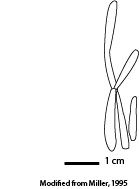Terebellina Ulrich, 1904
DESCRIPTION: Large, straight to curved, narrow, unbranched and elongate tubes, usually open at both ends, but may feature transverse constrictions or internal partitions; wall agglutinated, often thick relative to diameter of central lumen, and composed of sponge spicules, sand or silt grains, other skeletal material, or some combination of these bound together with organic cement; aperture located at broader end. Not over 15 cm long, averaging 2 mm in outside width, wall thickness of 0.6-0.7 mm.
BEHAVIOR(S): Repichnia, locomotion, resting, or foram tests
ENVIRONMENTAL SETTINGS: Marine and deep marine, Flysch deposits, of the Pacific borderlands.
POSSIBLE TRACEMAKERS: Bathysiphonid Foraminiferids
GEOLOGIC RANGE: Triassic-recent
ADDITIONAL REFERENCES: Moore, 1987; Loeblich and Tappan, 1988; Miller, 1988a; Bromley, 1990; Miller, 1995; Pemberton, S.G. (ed), 1992
REMARKS: The genus Terebellina was proposed by E. 0. Ulrich, 1904, for morphologically simple, siliceous, tubular macrofossils occurring in Cretaceous flysch of Kodiak Island and vicinity, western Gulf of Alaska, (Miller, M.III., 1995). In recent years several authors have suggested the possibility that most body fossils referred to Terebellina are, in fact, the tests of large bathysiphonid foraminiferids (Danner, 1975; Gregory, 1977; Moore, 1987; Miller, 1988a; Bromley, 1990), however, trace fossil workers continue to use the name Terebellina for curved burrows with thick grain-lined walls that are typically lighter colored than the surrounding sediment. Disagreement continues over biologic affinity, as well as the additional complication created by co-opting the name as an ichnogenus. “Terebellina is inappropriate as an ichnogeneric name,” Miller, 1995. Most of the burrows identified with this name probably should be considered ichnospecies of Palaeophycus where burrows are dominantly horizontal and occur individually, or Schaubcylindrichnus for curved bundles of grainlined burrows (Miller, 1995).
